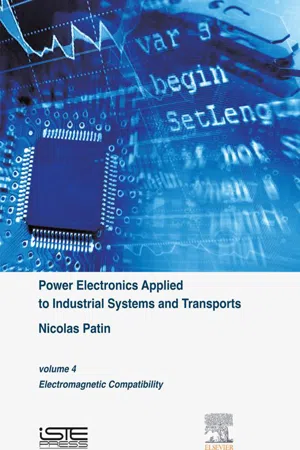
Power Electronics Applied to Industrial Systems and Transports, Volume 4
Electromagnetic Compatibility
- 216 pages
- English
- ePUB (mobile friendly)
- Available on iOS & Android
Power Electronics Applied to Industrial Systems and Transports, Volume 4
Electromagnetic Compatibility
About this book
If the operation of electronic components switching scheme to reduce congestion and losses (in power converters in general and switching power supplies in particular), it also generates electromagnetic type of pollution in its immediate environment.Power Electronics for Industry and Transport, Volume 4 is devoted to electromagnetic compatibility. It presents the sources of disturbance and the square wave signal, spectral modeling generic perturbation. Disturbances propagation mechanisms called "lumped" by couplings such as a common impedance, a parasitic capacitance or a mutual and "distributed constant", for which the spatial-temporal character must be taken into account, are also covered.This book also provides spectral analysis among other items that contain inequality Heisenberg-Gabor, very useful for understanding the spread spectrum PWM type signals.- Introducing essential notions in power electronics from both theoretical and technological perspectives- Detailed chapters with a focus on electromagnetic compatibility- Presented from a user's perspective to enable you to apply the theory of power electronics to practical applications
Frequently asked questions
- Essential is ideal for learners and professionals who enjoy exploring a wide range of subjects. Access the Essential Library with 800,000+ trusted titles and best-sellers across business, personal growth, and the humanities. Includes unlimited reading time and Standard Read Aloud voice.
- Complete: Perfect for advanced learners and researchers needing full, unrestricted access. Unlock 1.4M+ books across hundreds of subjects, including academic and specialized titles. The Complete Plan also includes advanced features like Premium Read Aloud and Research Assistant.
Please note we cannot support devices running on iOS 13 and Android 7 or earlier. Learn more about using the app.
Information
Introduction to EMC
Abstract
1.1 Problems and definitions
Table of contents
- Cover image
- Title page
- Table of Contents
- Copyright
- Preface
- 1. Introduction to EMC
- 2. Lumped Parameter Models
- 3. Distributed Element Models
- Appendix 1: Formulas for Electrical Engineering and Electromagnetism
- Appendix 2: Elements of Spectral Analysis
- Bibliography
- Index